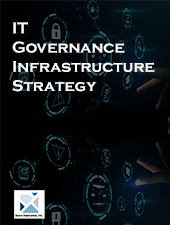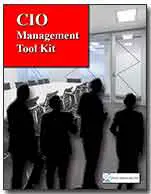CIO Planning Role Redefined
Successful CIOs have an ever expanding scope of responsibilities, create a bias toward learning that adapts well to changing business demands, aligning the organization to the business' strategic goals, and to having a cadre of strong IT professionals who understand that change is the norm.
CIO responsibilities now include:
- Strategy and Planning
- Control
- Service
- Risk Management
- Business Processes
- Strategic IT Initiatives
- Enterprise Infrastructure and Applications
Read on CIO Job Description Order CIO Job Description
CIOs now are starting to develop new information technology strategies. As they do that, they need to include understanding the fundamental business and operational trends that are driving businesses and enterprises of all types to redesign their operations. The principles that CIOs need to keep in mind are:
- Flexibility - CIOs must be able to respond to opportunities and challenges faster than ever before. These CIOs are usually battling well-resourced organizations that may be based where the opportunity originated, or another globalizing company that is reaching out for new opportunities. In order to compete, a CIO must create a strategy this helps the enterprise to more quickly deliver a product or service as well, or better, than that of potentially any other company in the world.
- Simplicity - The increase in technology has led to increased complexity. While per unit costs of technology are decreasing, in aggregate IT budgets continue to increase. With the pressure on IT to act less as a cost center and more as a way to increase the profitability of business units, adding more storage, more bandwidth, or additional technologies throughout the organization is no longer an acceptable approach to managing information technology. Instead, smart CIOs are investigating technologies like continuous data protection, virtualization, and wireless connectivity to help IT slim down its footprint while increasing their business's competitive advantages. Therefore, the IT team is typically in a difficult position, assessing where to cut costs while still moving forward with a plan to continually enhance IT services to the business.
- Security and Mandated Requirements - With the growing importance of applications and data, the sources of threats to enterprise data have multiplied dramatically. Everything from natural disasters, to criminals, and corrupt sources within the company can steal or corrupt data. While CIOs do everything that they can to stop these threats in the first place, they still must be prepared to recover from these threats as quickly as possible.
- Disaster Recovery Business Continuity - As businesses have expanded, the need for anytime, anywhere application access has become a requirement. At the same time, "follow the sun" (global 24/7) operations have shrinking maintenance windows and a need for applications to be running at all times. Delay or loss of data for any reason - system failure, natural disasters - has a domino-like effect across the entire organization, at any time of the day or night.
Read on Order Management Tool Kit
Security Risks Magnified With Staff Reductions
The question of what to do with unused IT equipment is a rapidly growing security problem for many companies hit by the recession and the accompanying layoffs. Countless desktops, laptops, servers and hand-held devices are lying around -- often with sensitive data on them -- gathering dust in cubicles, in stockrooms or on vacant desks. At the same time, software licenses, notoriously easy to lose track of, are also piling up. Many IT functions are under funded as enterprises drive for improved productivity and expense reductions. Decisions are made on in a spirit of making do. For example, Since no one is using the abandoned offices and equipment there is no risk. . .
When an organization is in survival mode, resources are being husbanded and everyone's working flat out, it takes a strength and leadership to say "no, not good enough" to something that is apparently working well. It is also difficult to justify more spending with no direct effect on revenues, and to demonstrate that something that seems optional is in fact required.
Responsibility for security and disaster recovery planning cannot be abdicated. It is hard enough for an organization to recover from a serious security breach at the best of times. These are not the best of times. Argued from the context of minimizing risk, the value of doing it right is clear. Make sure you're equipped to win that argument.
Read on Order Security Manual Template Download sample
Reducing Costs a Survival Skill
 In many enterprises, CIOs are perceived as mere technology managers, while in reality they should be viewed as business leaders. The CIO's focus should be on reducing costs and improving profitability through the strategic usage of IT. It is very important for the Information Technology organization to get out of a transactional mode. If the CIO has the right infrastructure in place, then the CIO can help in directing the strategy of the enterprise, and even shape its destiny. The CIO brings his own perspective, and without them, enterprises cannot build a robust operating environment.
In many enterprises, CIOs are perceived as mere technology managers, while in reality they should be viewed as business leaders. The CIO's focus should be on reducing costs and improving profitability through the strategic usage of IT. It is very important for the Information Technology organization to get out of a transactional mode. If the CIO has the right infrastructure in place, then the CIO can help in directing the strategy of the enterprise, and even shape its destiny. The CIO brings his own perspective, and without them, enterprises cannot build a robust operating environment.
The CIO Infrastructure Tool Kit is comprised of a collection of Janco products that CIOs and Directors' of IT can use to create a strategy and manage in today's interesting times.
Many CIOs are looking for ways to reduce expenses -- some eliminate staff others look for areas where usage costs can be reduced. Areas where many successful CIO focus are:
- Reducing power/cooling costs - IDC, the research firm, estimates that for every $1.00 spent on new servers today, an additional $0.50 is spent on power and cooling. In 2010, that ratio is expected to be $0.70 per $1.00 spent for new servers. Begin by turning off servers not being used and replacing older high power consumers and high heat producers with newer more efficient ones.
- Reducing complexity - Consolidate multiple operating systems onto fewer servers. This will reduce operational risk and operational costs that are linked to managing so many servers. Clustering will benefit by having the option of "failing over" workloads to virtual servers, reducing the operational costs of deploying standby physical server machines that run in a "passive" mode rather than an "active" mode. Taken together, these approaches improve the responsiveness of IT systems and of the people who access them across the business, ensuring high levels of availability, reducing business risk, and operating expenses.
- Improving the management of physical and virtual servers - Reducing the total number of systems simplifies IT operations and affects IT staffing requirements. Importantly, downtime is impacted by having fewer individual points of management.
- Going Green - The process of IT transformation brings the opportunity to change the IT infrastructure, supporting "go green" initiatives by reallocating workloads to the sets of server and storage devices on which they can run most efficiently and reducing total server footprints through workload consolidation.
Read On Order IT Governance Strategy Download Sample


